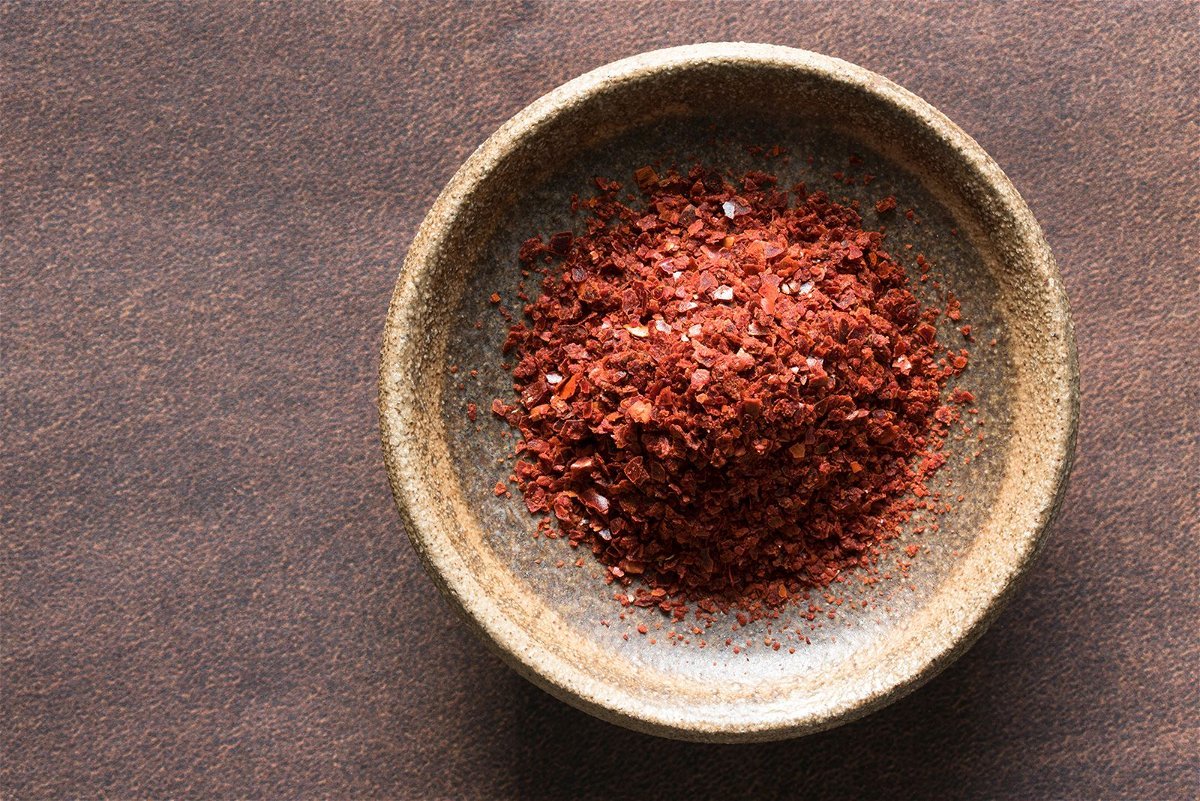How to spice up your pantry the Mediterranean way

Suzy Karadsheh describes Aleppo pepper as “a magical chile flake
By Susan Puckett, CNN
(CNN) — Sign up for CNN’s Eat, But Better: Mediterranean Style. Our eight-part guide shows you a delicious expert-backed eating lifestyle that will boost your health for life.
I never realized I needed sumac and Aleppo pepper in my life until I met Suzy Karadsheh, the popular Egyptian-born blogger. She had me and my husband over to her home in the Atlanta suburbs for a feast of the Mediterranean flavors that made her a social media star.
The highlight was a platter of boldly seasoned, rosy-hued drumsticks hot off the grill, unlike any other barbecued chicken I’d ever tasted. The inspiration, she explained, was a dish called musakhan that her Palestinian friends made during the olive oil season in which chicken was slow-roasted and heaped with caramelized onions over olive oil-drenched flatbread. Her speedier chargrilled rendition subbed quick-pickled onions for the caramelized ones, with the bread served on the side.
What connected her modern creation to the traditional recipe was the marinade those conveniently packaged poultry parts were bathed in: pureed onions and garlic, citrus, olive oil and myriad spices. I detected the warm hints of coriander, cinnamon and allspice prevalent in so much of Middle Eastern cuisine. But it was the tart, earthy, tingly, subtly sweet notes provided by the sumac and Aleppo pepper that made such a lasting impression.
Old cuisines spark new cravings
The Mediterranean style of eating has won heaps of international praise in recent years not only for its health benefits but also for its broad appeal and flexibility.
Extra-virgin olive oil, yogurt and feta cheese are dietary mainstays, along with seasonal produce, legumes, whole grains and lean proteins. But it’s the spices, condiments and other pantry staples that make those simple foods taste of certain places within that vast, diverse region that stretches from southern Europe to North Africa and the Middle East.
I developed a deep appreciation for these nuances while working with Karadsheh through the pandemic and after as her writing collaborator on “The Mediterranean Dish: 120 Bold and Healthy Recipes You’ll Make on Repeat,” her best-selling cookbook based on the blog of the same name.
I was happy to realize early on that I wouldn’t have to conduct a wide search for the distinctive seasoning blends that characterize much of her cooking. Most are homemade blends made from spices I used regularly for a variety of cuisines, such as cumin, paprika, cinnamon and turmeric.
“There are a handful that may be a little harder to come by that I can’t live without,” she told me. Some are available on her website, and more are entering mainstream markets as demand for more diverse Mediterranean flavor options grows.
Two spices to get to know
Aleppo pepper and sumac are widely used throughout the Mediterranean, often together in the same recipe. And both have enormous potential beyond those boundaries as evident in the number of recipes where they show up in popular mainstream cookbooks, magazines and online resources.
Made from deep-red Halaby chile peppers, Aleppo pepper is named for the Syrian city where it once grew in abundance. Due to the war in Syria, however, most of what’s available now comes from Turkey and elsewhere.
Karadsheh describes Aleppo pepper as “a magical chile flake with mild heat that, in addition to a bit of a kick, has a fruity, tangy taste akin to sun-dried tomatoes. It’s great sprinkled on everything from salad to steak to popcorn to even watermelon.”
It’s about half as spicy-hot as generic red chile flakes but delivers a slow-building, flavor-packed heat that can elevate any pizza slice, avocado toast, grilled meat, can of white beans, or sheet pan of simple roast vegetables.
Sumac is a coarse, deep red spice made from the berry of a shrub (not the poisonous one by the same name) with a flavor that’s simultaneously sour, smoky and earthy, with some floral notes. In the Middle East, Karadsheh said, it was often used in place of citrus when lemons were out of season. Because it acts as a “dry acid,” it can bring out the natural flavors of food much like salt does and makes a great component in a dry rub for meat, chicken or fish.
She also suggests adding a dash to a simple olive oil and lemon juice salad dressing, folding a pinch into brownie batter or cookie dough, or sprinkling it on hummus. Check labels to make sure you’re getting an all-natural spice; some mass-market brands may be mixed with citric acid and food coloring.
Multilayered histories in a bottle
Several premixed seasoning blends with long histories in the Middle East are finding homes in Western kitchens lately.
Za’atar, a complex blend of sumac, toasted sesame seeds, wild thyme and other spices, ranks as one of Karadsheh’s most-used pantry ingredients. She sprinkles it regularly on homemade bread rolls, avocados, sliced tomatoes and roast chicken. Quality varies from one brand to the next, and she advises reading labels to make sure they’re all natural and free of fillers or additives such as citric acid.
If you’re trying a new seasoning such as za’atar for the first time, Karadsheh suggests adding a sprinkle to something simple you can easily adjust, such as a plain green salad with a light vinaigrette, a yogurt-based dip for pita or raw vegetables, or olive oil for dunking hearty bread, to determine how far you want to go with it.
Dukkah, a crunchy, heady blend of nuts, seeds and warm spices, was a staple of Karadsheh’s Egyptian childhood and is always in her kitchen today. Although sometimes sold in jars, she said, it’s easy to make yourself and it’s much better fresh. She sprinkles it on soups, salads, roasted vegetables and anything that could use a crunchy, savory topping. Served with pita and olive oil, it makes an instant snack or appetizer.
Ras el hanout, baharat, shawarma and dry harissa all involve combinations of warm spices that vary with the maker, and any are worth having on hand to punch up a stew, a dry rub for meats, or a pilaf in a hurry.
Want to make it from scratch?
If you don’t want to go to the trouble of sourcing them, there’s likely plenty of exciting alchemy waiting to be mixed up from your cupboards already.
“It’s always good to keep in mind that the number of ingredients in a recipe does not necessarily equal the difficulty,” Karadsheh said.
“We like to use a lot of spices, but most of the time it’s not complicated. You just throw the stuff in one big pan or pot, give it a stir, and you’re good to go. It’s not difficult to cook the Mediterranean way.”
Susan Puckett is the former food editor of The Atlanta Journal-Constitution and author of “Eat Drink Delta: A Hungry Traveler’s Journey Through the Soul of the South.”
The-CNN-Wire
™ & © 2023 Cable News Network, Inc., a Warner Bros. Discovery Company. All rights reserved.



